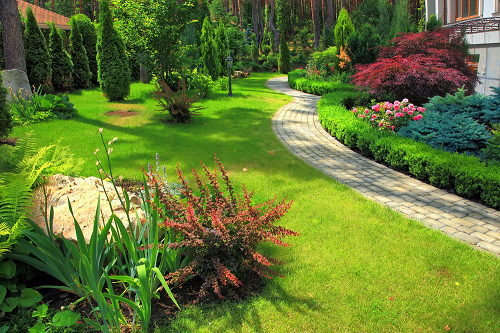Tips and Ideas for a Xeriscape Santa Rosa Project
The movement to xeriscaping has taken hold of arid regions in the United States. With the seldom rains and insufficient water in these areas, maintaining an attractive and healthy lawn is not easy. Xeriscaping provides for a viable alternative for conventional landscaping where non-native plants are introduced to your backyard. These are often slow-growing and drought-tolerant providing you with a hearty and simple environment even in the most stringent climates.
Why Convert to Xeriscape?

Converting to xeriscaping is understandably a big decision for any homeowner. But given the benefits, you should probably consider making this very desired landscape change. Benefits of xeriscaping include:
- Preserving water quality
Xeriscaping requires fewer inputs which in turn reduces the number of chemicals that reach underground water reservoirs. Additionally, the plants that replace the traditional lawn grasses mirror the agroecosystem which act as sufficient filters for groundwater.
- Saves water
Landscaping water requirements have been a thorny issue. For traditional landscaping plants to survive, they require what could be considered excessive irrigation. Note that when done right and properly maintained, xeriscaping has been proven to use just half of the water used on the traditional landscape.
- Low maintenance
Compared to traditional landscaping, xeriscaping boosts of being low maintenance. It eliminates the need for recurrent pruning, tending, mowing, and fertilizing. The plants introduced are often indigenous to the region’s climate and as such little human intervention is required. Still, you should understand that xeriscaping in Santa Rosa requires some grounds keeping.
- Conserves the environment
Grass clippings from conventional landscaping end up in waste landfills. When you convert to xeriscaping, you eliminate the need for mowing and scalping which significantly reduces the waste output. Besides, traditional lawns are usually heavy water users and require inputs that might harm the biodiversity of your lawn.
- Decreases noise pollution
Nothing ruins a silent atmosphere than the loud noise of lawnmowers. Fortunately, when you get into xeriscaping you eliminate the need for mowing. Besides, you can landscape for noise cancellation. This can be done by including deciduous trees and shrubs which are then planted on the edge of your yard.
Tips for a Xeriscape Santa Rosa Project
As you consider xeriscaping, you should probably keep in mind that you should start small. You can go with a zone along your driveway where you could start with perennial shrubs. This small zone should be indicative of the amount of water and finances you might need as you undertake the rest of your yard.
Additional tips include:
- Clump and Scatter Gardening
Arid and semi-arid areas often have to deal with having insufficient rain. In response, these areas are often devoid of cover crops which means that the topsoil is often eroded. As a consequence, the garden soil is often infertile which discourages any gardening you embark on. As a pro tip for your xeriscaping, consider scatter gardening. The ground is then less exposed to the sun which preserves soil moisture eliminating the need for more watering.
- Monochrome Rock Gardening
The monochrome rock garden design is a favorite for xeriscaping beginners. You get to landscape your space with your favorite color, shades, and textures. You should consider having a single-color theme throughout which result in blissful harmony. Curve pathways with your favorite shades that verdant the space. You can also utilize irregular forms of bushes which create a visual interest in your yard.
- Use rows
To incorporate rows into your xeriscaping, consider having the tallest plants at the very back of the yard. In between these, include grasses and flowering shrubs which bring color to the overall design. These work as cover crops ensuring that the spaces in between the rows do not get direct exposure to the sun hence further conservation.
- Rock Garden
If your yard has slopes or terraces, consider clumping your succulents instead of putting them in lines. To ensure the maximization of the water used, place the plants that require the most water at the bottom of the clump. You can arrange these in a design that shows off their color or texture.
- Improve soil quality
You should incorporate mulching and compositing to build your soil’s organic matter. This should include diversifying the plants incorporated in your yard. Additionally, utilize soil amendments whose environmental footprint is negligible.
- Appropriate landscape maintenance
To keep your landscape flourishing, you should efficiently clip overgrowth as you would with traditional landscaping. This timely pruning ensures that your lawn has continuous growth throughout the seasons. Additionally, keep weeds under control by consistently tending to the new growth. You should also consider light top dressing with suitable fertilizer or manure.
- Pre-determine your xeriscaping goals
The universal xeriscaping goal is maintaining a beautiful, healthy lawn while effectively using water. However, you must establish and maintain a personal goal for this endeavor. This could be eliminating the need for consistent maintenance or accomplishing a different look in your yard.
Decide to go with a xeriscape Santa Rosa project and introduce color, beauty, and function to your yard even when you are in desert-like conditions. At best, it is common-sense landscaping that requires good planning and efficient use of water. By incorporating the aforementioned tips, it ensures that you successfully convert to a beautiful lawn that has minimal maintenance and longevity. Contact us for more information.
Tagged: garden maintenance, landscaping
You can leave a response, or trackback from your own site. Back to Top
Leave a Reply





